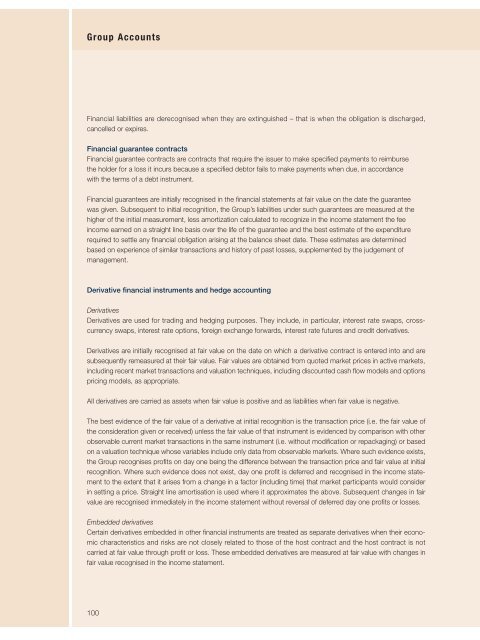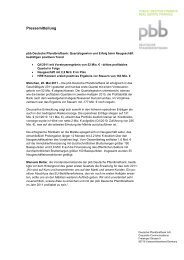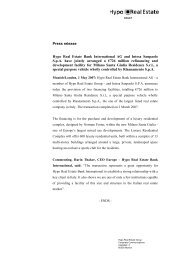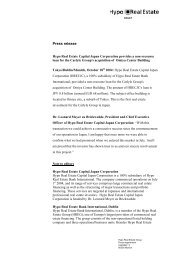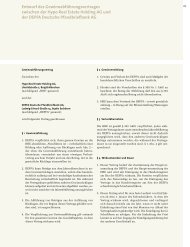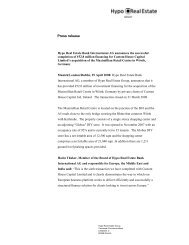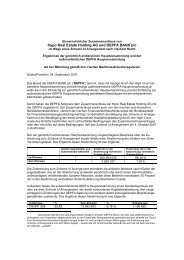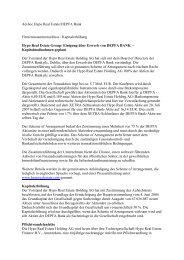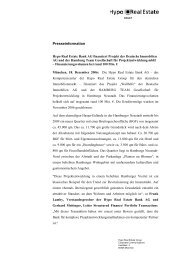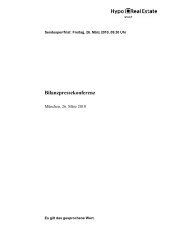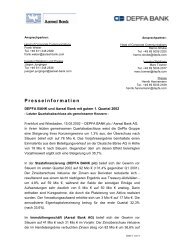annual report - Hypo Real Estate Holding AG
annual report - Hypo Real Estate Holding AG
annual report - Hypo Real Estate Holding AG
Create successful ePaper yourself
Turn your PDF publications into a flip-book with our unique Google optimized e-Paper software.
Group Accounts<br />
Financial liabilities are derecognised when they are extinguished – that is when the obligation is discharged,<br />
cancelled or expires.<br />
Financial guarantee contracts<br />
Financial guarantee contracts are contracts that require the issuer to make specified payments to reimburse<br />
the holder for a loss it incurs because a specified debtor fails to make payments when due, in accordance<br />
with the terms of a debt instrument.<br />
Financial guarantees are initially recognised in the financial statements at fair value on the date the guarantee<br />
was given. Subsequent to initial recognition, the Group’s liabilities under such guarantees are measured at the<br />
higher of the initial measurement, less amortization calculated to recognize in the income statement the fee<br />
income earned on a straight line basis over the life of the guarantee and the best estimate of the expenditure<br />
required to settle any financial obligation arising at the balance sheet date. These estimates are determined<br />
based on experience of similar transactions and history of past losses, supplemented by the judgement of<br />
management.<br />
Derivative financial instruments and hedge accounting<br />
Derivatives<br />
Derivatives are used for trading and hedging purposes. They include, in particular, interest rate swaps, crosscurrency<br />
swaps, interest rate options, foreign exchange forwards, interest rate futures and credit derivatives.<br />
Derivatives are initially recognised at fair value on the date on which a derivative contract is entered into and are<br />
subsequently remeasured at their fair value. Fair values are obtained from quoted market prices in active markets,<br />
including recent market transactions and valuation techniques, including discounted cash flow models and options<br />
pricing models, as appropriate.<br />
All derivatives are carried as assets when fair value is positive and as liabilities when fair value is negative.<br />
The best evidence of the fair value of a derivative at initial recognition is the transaction price (i.e. the fair value of<br />
the consideration given or received) unless the fair value of that instrument is evidenced by comparison with other<br />
observable current market transactions in the same instrument (i.e. without modification or repackaging) or based<br />
on a valuation technique whose variables include only data from observable markets. Where such evidence exists,<br />
the Group recognises profits on day one being the difference between the transaction price and fair value at initial<br />
recognition. Where such evidence does not exist, day one profit is deferred and recognised in the income statement<br />
to the extent that it arises from a change in a factor (including time) that market participants would consider<br />
in setting a price. Straight line amortisation is used where it approximates the above. Subsequent changes in fair<br />
value are recognised immediately in the income statement without reversal of deferred day one profits or losses.<br />
Embedded derivatives<br />
Certain derivatives embedded in other financial instruments are treated as separate derivatives when their economic<br />
characteristics and risks are not closely related to those of the host contract and the host contract is not<br />
carried at fair value through profit or loss. These embedded derivatives are measured at fair value with changes in<br />
fair value recognised in the income statement.<br />
100


